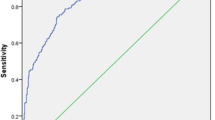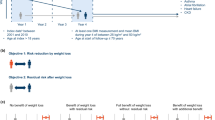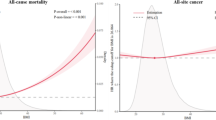Abstract
We have previously shown that antibody titres to several heat-shock proteins (Hsps) are elevated in dyslipidaemic patients and subjects with established vascular disease. Obesity is known to be associated with raised serum inflammatory markers suggesting a state of heightened immune activation. Hence, we have investigated the association between indices of obesity and several Hsp antibody titres in healthy subjects. Subjects (n=170) were recruited from among employees at the University of Surrey and the Royal Surrey County Hospital, Guildford, UK. Of these subjects, 35 were obese with a body mass index (BMI)⩾30 kg/m2 (19 male and 16 female subjects), 58 were overweight with 30>BMI⩾25 kg/m2 (36 male and 22 female subjects) and 77 were of a normal weight with BMI<25 kg/m2 (31 male and 46 female subjects). Overall, obese subjects had significantly higher plasma anti-Hsp-60 (P<0.001), anti-Hsp-65 (P<0.05) and anti-Hsp-70 (P<0.05) compared with overweight and normal weight subjects.
This is a preview of subscription content, access via your institution
Access options
Subscribe to this journal
Receive 12 print issues and online access
$259.00 per year
only $21.58 per issue
Buy this article
- Purchase on SpringerLink
- Instant access to full article PDF
Prices may be subject to local taxes which are calculated during checkout
Similar content being viewed by others
References
Morimoto RI . Cells in stress: transcriptional activation of heat shock genes. Science 1993; 259: 1409–1410.
Udelsman R, Blake MJ, Stagg CA, Li DG, Putney DJ, Holbrook NJ . Vascular heat shock protein expression in response to stress. Endocrine and autonomic regulation of this age-dependent response. J Clin Invest 1993; 91: 465–473.
Lamb DJ, El Sankary W, Ferns GA . Molecular mimicry in atherosclerosis: a role for heat shock proteins in immunization. Atherosclerosis 2003; 167: 177–185.
Burian K, Kis Z, Virok D, Endresz V, Prohaszka Z, Duba J et al. Independent and joint effects of antibodies to human heat-shock protein 60 and Chlamydia pneumoniae infection in the development of coronary atherosclerosis. Circulation 2001; 103: 1503–1508.
Huittinen T, Leinonen M, Tenkanen L, Manttari M, Virkkunen H, Pitkanen T et al. Autoimmunity to human heat shock protein 60, Chlamydia pneumoniae infection, and inflammation in predicting coronary risk. Arterioscler Thromb Vasc Biol 2002; 22: 431–437.
Prohaszka Z, Duba J, Horvath L, Csaszar A, Karadi I, Szebeni A et al. Comparative study on antibodies to human and bacterial 60 kDa heat shock proteins in a large cohort of patients with coronary heart disease and healthy subjects. Eur J Clin Invest 2001; 31: 285–292.
Trayhurn P, Wood IS . Signalling role of adipose tissue: adipokines and inflammation in obesity. Biochem Soc Trans 2005; 33: 1078–1081.
Ghayour-Mobarhan M, Ferns G, Taylor A . Assessment of two bio impedance analysers for measuring body fat composition: effects of biological variation. Proc Nutr Soc 2002; 61: 126A (Abstract).
Friedwald W, Levy R, Fredrickson D . Estimation of low density lipoprotein cholesterol in plasma without the use of preparative ultracentrifugation. Clinica Chimica Acta 1972; 18: 499–502.
Ghayour-Mobarhan M, New S, Lamb D, Starkey B, Livingstone C, Wang T et al. Dietary antioxidants and fat are associated with plasma antibody titres to heat shock proteins-60, -65 and -70 in subjects with dyslipidaemia and metabolic syndrome. Am J Clin Nutr 2005; 81: 998–1004.
Metzler B, Xu Q, Wick G . The role of (auto-) immunity in atherogenesis. Wien Klin Wochenschr 1998; 110: 350–355.
Bonk M, Tadros M, Vandekerckhove J, Al Babili S, Beyer P . Purification and characterization of chaperonin 60 and heat-shock protein 70 from chromoplasts of Narcissus pseudonarcissus. Plant Physiol 1996; 111: 931–939.
Flores AI, Cuezva JM . Identification of sequence similarity between 60 kDa and 70 kDa molecular chaperones: evidence for a common evolutionary background? Biochem J 1997; 322 (Part 2): 641–647.
Kocsis J, Veres A, Vatay A, Duba J, Karadi I, Fust G et al. Antibodies against the human heat shock protein hsp70 in patients with severe coronary artery disease. Immunol Invest 2002; 31: 219–231.
Xu Q, Schett G, Perschinka H, Mayr M, Egger G, Oberhollenzer F et al. Serum soluble heat shock protein 60 is elevated in subjects with atherosclerosis in a general population. Circulation 2002; 102: 14–20.
Kervinen H, Huittinen T, Vaarala O, Leinonen M, Saikku P, Manninen V et al. Antibodies to human heat shock protein 60, hypertension and dyslipidemia. A study of joint effects on coronary risk. Atherosclerosis 2003; 169: 339–344.
Zhu J, Quyyumi AA, Wu H, Csako G, Rott D, Zalles-Ganley A et al. Increased serum levels of heat shock protein 70 are associated with low risk of coronary artery disease. Arterioscler Thromb Vasc Biol 2003; 23: 1055.19–1059.19.
Sims TJ, Lernmark A, Mancl LA, Schifferle RE, Page RC, Persson GR . Serum IgG to heat shock proteins and Porphyromonas gingivalis antigens in diabetic patients with periodontitis. J Clin Periodontol 2002; 29: 551–562.
Mehta TA, Greenman J, Ettelaie C, Venkatasubramaniam A, Chetter IC, McCollum PT . Heat shock proteins in vascular disease – a review. Eur J Vasc Endovasc Surg 2005; 29: 395–402.
Acknowledgements
MGM is a scholar of the Iranian Government. DJL was partially supported by the British Heart Foundation and a Bridging Grant from the University of Surrey.
Author information
Authors and Affiliations
Corresponding author
Rights and permissions
About this article
Cite this article
Ghayour-Mobarhan, M., Taylor, A., Lamb, D. et al. Association between indices of body mass and antibody titres to heat-shock protein-60, -65 and -70 in healthy Caucasians. Int J Obes 31, 197–200 (2007). https://doi.org/10.1038/sj.ijo.0803385
Received:
Revised:
Accepted:
Published:
Issue date:
DOI: https://doi.org/10.1038/sj.ijo.0803385
Keywords
This article is cited by
-
Prediction of serum anti-HSP27 antibody titers changes using a light gradient boosting machine (LightGBM) technique
Scientific Reports (2023)
-
Overheating or overcooling: heat transfer in the spot to fight against the pandemic obesity
Reviews in Endocrine and Metabolic Disorders (2021)
-
Serum high-sensitivity C-reactive protein as a biomarker in patients with metabolic syndrome: evidence-based study with 7284 subjects
European Journal of Clinical Nutrition (2016)
-
The 60- and 70-kDa heat-shock proteins and their correlation with cardiovascular risk factors in postmenopausal women with metabolic syndrome
Cell Stress and Chaperones (2014)
-
Circulating anti-Hsp70 levels in nascent metabolic syndrome: the Casale Monferrato Study
Cell Stress and Chaperones (2013)



